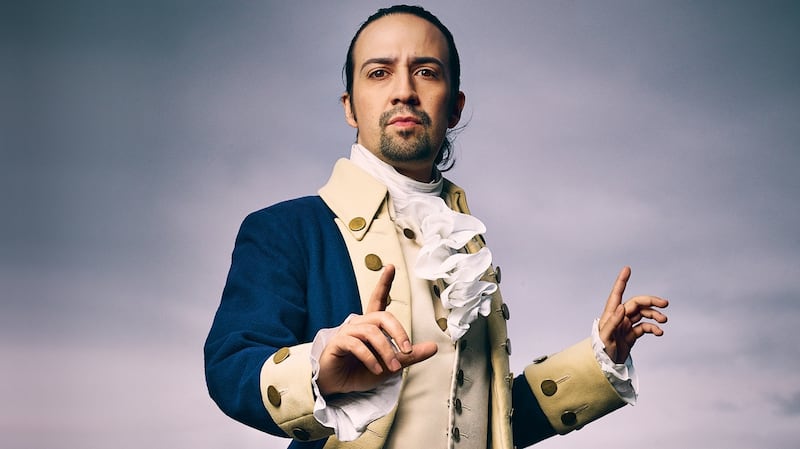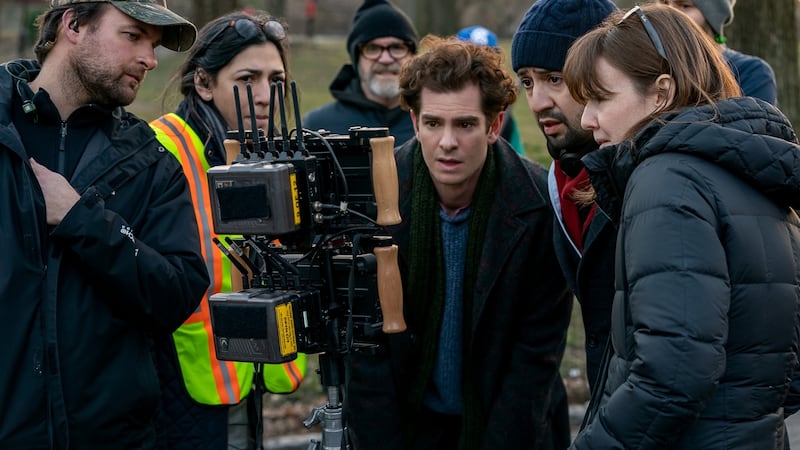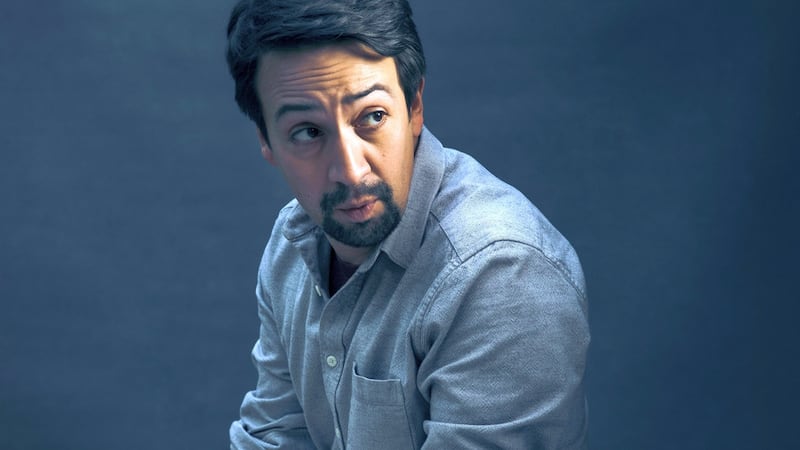“On legacy, one of the main messages in Hamilton is: you don’t get a say,” Lin-Manuel Miranda explains. “All you get to do is make what you make, and the world will do with it what it does.”
The composer, joining us as Tick, Tick… Boom!, his debut as feature director, arrives to cinemas and Netflix, has had opportunity to ponder that lesson over the last six years. Nobody else in his field has had this degree of fame thrust on them so quickly. Stephen Sondheim may still be the undisputed dean of musical theatre, but he has never delivered a smash of his own – his collaboration on West Side Story is another issue – to compare with Miranda's Hamilton. Andrew Lloyd Webber's journey took a few giant steps. Neither Rodgers nor Hammerstein were ever exactly celebrities.
Miranda already had a significant hit with In the Heights when Hamilton, a hip-hop infused study of US founding father Alexander Hamilton, arrived off-Broadway in 2015. But this was something else. The transfer to the Richard Rodgers Theatre on the Great White Way was a sensation. It broke records at the Tony Awards with 16 nominations. It won a Pulitzer Prize. The actors performed at the White House. No cast album had debuted so high in the Billboard charts since 1963. The musical's success caused the treasury secretary to cancel plans to remove Hamilton from the $10 bill. Hamilton was thus confirmed as a key cultural text of the later Obama years.

Suddenly, Miranda had to cope with questions about what he had done to the musical. In the years since Hamilton’s debut, his school of playful rap infused with eclectic melodies has spread across interlocked media: animated films, mainstream pop, Netflix crowd-pleasers. The show has made the case for colour-blind casting everywhere. But it is on Broadway and the West End that the influence will really tell. There has not been as busy a game-changer since Jesus Christ Superstar and Godspell (whatever you think of those shows).
Miranda brings us back to Jonathan Larson’s Tick, Tick… Boom! Originally a cult hit off-Broadway in the early 1990s, the show details the late composer’s early experiences on the slow road to (sadly) posthumous success with the downtown-Boho hit Rent.
Hamilton, which famously cast people of multiple races to play the snow-white framers of the US constitution, was poked and probed for signs of political deviancy
"I can tell you that everything that's good in Hamilton was inspired by seeing Rent by Jonathan Larson on my 17th birthday," Miranda says. "I saw a homemade musical set in New York. I saw the most diverse cast I'd ever seen on Broadway. I saw something that felt like it was now. It just felt thrillingly now. You have to remember, by the time I was 17, A Chorus Line is a period piece, West Side Story is a period piece. It was the first truly contemporary musical I remember seeing, and it was the first musical I could see that made me feel I could write a musical. It sent me careering in that direction."
Tick, Tick… Boom! features an eccentric performance by Bradley Whitford as a supportive Sondheim. It seems that the composer and lyricist, already an grizzled veteran by the time of Larson’s emergence, was there to offer the younger man support when the rest of New York provided only a cold shoulder.

"There is a way in which we're all links in the chain," Miranda says. "I was inspired to start writing by Jonathan Larson. Jonathan Larson was generously mentored by Stephen Sondheim, who's mentored countless generations of writers, and it felt only right to put him in this movie. And I think he did that because [lyricist] Oscar Hammerstein let him in his house when he was 10 years old and was looking to get out of his mom's house. He gave him a masterclass in writing and telling stories for the theatre. So, you know, it all stretches back to Oscar."
Miranda’s journey to triumph has some parallels with Larson’s early struggles. Born in New York City, he is the son of Luz Towns-Miranda, a psychologist, and Luis Miranda jnr, a prominent Democratic Party consultant. Both parents are from Puerto Rico. Raised in upper Manhattan, not far from Washington Heights, the area that inspired In the Heights, Miranda began performing in and writing musicals while still at Hunter College High School. He wrote the first version of Into the Heights in 1999, when he was just 19. That show premiered off-Broadway in 2007 and then on the bigger stage a year later. So it sounds as if he did have a few years kicking about New York in bohemian squalor. I guess the city had changed since Larson’s experiences in 1990. That was at the height of the Aids crisis. Bits of downtown Manhattan had not yet been gentrified.
“I come from a lived experience of New York City in 1990. But I was 10 years old,” he says. “I remember playing in the ante-rooms of funeral homes while my mother went to funerals of friends that she and my father lost to the Aids virus. I remember experiencing that as a kid. One of my sixth-grade teachers taught us about Aids education in 1992 – when this was still mysterious to a lot of people and certainly wasn’t being taught to kids. I realised in hindsight how incredible that was.”

That tragedy is in there. But the film is also infused with the romance of the struggling artist. Jonathan’s life, for all its inconveniences, feels more enticing than that of his ad-executive best pal. Is that how Lin remembers it?
“One of the reasons I wanted to make this film was I do know what it is like to be a struggling songwriter,” he says. “In my 20s I didn’t work at a diner. I worked as a teacher – and as a substitute teacher at my old high school. I danced at bar mitzvahs. I sang back-up in children’s choirs. I did whatever jobs required the least amount of time, so that I could have the most time to write. And I shared that with Jonathan.”
He didn’t fully grasp the connections until the film was finished.
Earlier this year, he issued an apology when the film of In the Heights was chastised for not casting sufficient dark-skinned Afro-Latino actors
“The first person I screened this for was one of my best friends, Quiara [Alegría Hudes], who wrote In the Heights with me,” he says. “She came over to my apartment to watch the rough cut, and as soon as they cut to Jonathan’s bedroom, she turned to me and went: ‘Lin, that’s your bedroom. That’s your futon on the floor from when you were 25.’ And I burst into tears and said: ‘Oh my God, this will be so personal.’ But it hadn’t really occurred to me how personal until someone who knew me said: ‘That’s your room, dude’.”
So when did that struggle end? We know about the success after Hamilton. He turned up as a variation on the Dick van Dyke character from Mary Poppins in Mary Poppins Returns. He has written songs for Disney animations such as Moana and next week’s Encanto. He is appearing as Lee Scoresby in the continuing TV adaptation of Philip Pullman’s His Dark Materials. So, yes, the world opened up for him when Hamilton hit. But he had cast off obscurity some years before. In the Heights did, after all, win the Tony for Best Musical. When did he know he had escaped his “other job” years?
“It was when In the Heights started to play on Broadway,” he says. “And I still lived all the way uptown. I lived at the last stop on the train. I remember the first time I didn’t take the train. I hailed a cab, and I didn’t have to do math to check if I could afford this cab ride all the way uptown. Because that’s, like, 25 bucks. That was my first guilt-free cab ride. I thought: oh, this is going to be okay. I don’t have to now work out how this deal enters into my cable bill and my utilities. And that was that was a wonderful moment – my first conscience-free cab ride uptown. Nice!”

The considerably greater renown he achieved when Hamilton hit has brought its downsides. Fame has always sent its beneficiaries – or victims – along a sine wave of acclaim and disparagement, but those peaks and troughs are more pronounced in era of social media and instant online screeds. His show, which famously cast people of multiple races to play the snow-white framers of the US constitution, was poked and probed for signs of political deviancy. One prominent academic, unimpressed by the lack of any enslaved characters, wrote an essay entitled “Race-Conscious Casting and the Erasure of the Black Past in Lin-Manuel Miranda’s Hamilton”. Ishmael Reed, a prominent black writer, went so far as to stage an unimpressed play entitled The Haunting of Lin-Manuel Miranda.
There was criticism of his support for a Bill aimed at restructuring Puerto Rico’s debt following Hurricane Maria. Earlier this year, he issued an apology when the film of In the Heights was chastised for not casting sufficient dark-skinned Afro-Latino actors. These are problems he didn’t have when he still had to “do the math” before taking a cab ride.
Yet it looks as if he is here to stay. Featuring a barn-storming performance by Andrew Garfield, Tick, Tick… Boom! looks set to figure in the Oscar considerations. The brightly coloured Encanto, buoyed up by his fizzing songs, is sure to be a hit. Then there is musical theatre. He still has possession of the ball. The song 'n' dance community is still watching.
“And what can we do when we have the ball?” he says. “I don’t know what the new generations will do with the ball. But I’m thrilled that I even got the ball for a minute.”
Tick, Tick… Boom! is streaming on Netflix from November 19th




















